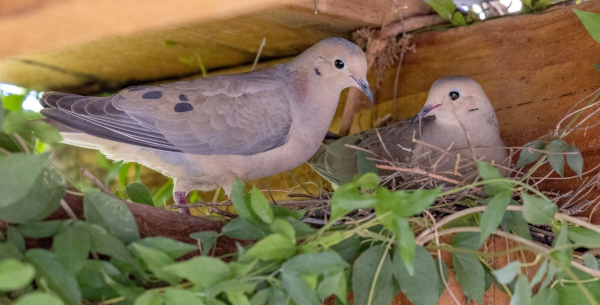
A pair of Mourning Doves at their nest, where they take turns incubating their clutch of 2 eggs during the 2 week incubation period (photo by Michael Sadat).

Nestlings of Common Grackles grow quickly and fledge between 16 and 20 days after hatching.
|
Through our landscaping, water features, and feeding stations, we attract birds to our yards and neighborhoods, and for weeks birds have been assessing our backyard habitats with for appropriate nesting sites. Inspecting our trees, shrubs, hedges, flower gardens, decorative grasses, and lawns, as well as nest boxes. The nesting season is an exciting time anywhere; in some areas of the Sunbelt, nesting has been on-going for a few months, while in more northern latitudes the first broods of early nesting birds are beginning to fledge – American Robins and Mourning Doves for example.
Throughout the continent there is a nesting and post-nesting energy, with new fledglings adding to populations. Even if your landscaping isn’t being used directly by birds building nests and raising nestlings, the availability of a source of clean fresh water and summer foods may be part of the reason birds are nesting nearby, and still visiting your yard to forage for caterpillars and insects in your trees, bushes, and grass, then returning to feed growing nestlings in a nest hidden a block or so away.
As birders, we are always interested to learn more about the birds we share our yards and neighborhoods with, and there are great published resources for us – online, at a library, or in your own library of bird books. Even so, we thought you would be interested in a concise list of information about familiar backyard birds that provides the average number of eggs in a clutch of a variety of common species, along with the length of the incubation period, and the number of days nestlings spend in the nest before they fledge – all this info in one location that you can print out and refer to anytime – Here!
Below you can find and compare many details about some of the birds you see outside your windows, at your feeding station and bird bath, or in your yard and in your neighborhood.
. Species: Clutch Size, Incubation Period, Nestling Period
American Robins: 4 eggs, 13 days incubation, 15 days to fledging
Mourning Doves: 2 eggs, 14 days incubation, 13 to 15 days to fledging
Northern Cardinals: 3 or 4 eggs, 12 or 13 days incubation, 11 or 12 days to fledging
Baltimore Orioles: 4 or 5 eggs, 12 to 14 days incubation, 12 to 14 days to fledging
Bullock’s Orioles: 4 or 5 eggs, 12 to 14 days incubation, 12 to 14 days to fledging
Orchard Orioles: 4 to 6 eggs, 12 to 14 days incubation, 14 days to fledging
Northern Mockingbirds: 3 to 5 eggs, 13 days incubation, 11 days to fledging
Eastern Bluebirds: 4 or 5 eggs, 13 days incubation, 15 to 20 days to fledging
Mountain Bluebirds: 4 to 6 eggs, 13 days incubation, 22 or 23 days to fledging
Western Bluebirds: 5 eggs, 14 days incubation, 20 to 22 days to fledging
Tree Swallows: 4 to 6 eggs, 13 to 14 days incubation, 18 to 22 days to fledging
Barn Swallows: 4 or 5 eggs, 14 days incubation, 21 days to fledging
House Wrens: 6 to 8 eggs, 13 days incubation, 12 to 18 days to fledging
Bewick’s Wrens: 5 to 7 eggs, 13 days incubation, 13 to 17 days to fledging
Carolina Wrens: 5 eggs, 13 days incubation, 12 to 14 days to fledging
Black-capped Chickadees: 6 to 8 eggs, 11 to 13 days incubation, 14 to 18 days to fledging
Carolina Chickadees: 6 eggs, 11 or 12 days incubation, 12 to 18 days to fledging
Tufted Titmouse: 5 to 7 eggs, 13 days incubation, 13 to 17 days to fledging
American Goldfinches: 4 to 6 eggs, 10 to 12 days incubation, 11 to 17 days to fledging
Lesser Goldfinches: 4 or 5 eggs, 12 days incubation, 12 to 16 days to fledging
Ruby-throated Hummingbirds: 2 eggs, 11 to 14 days incubation, 14 to 21 days to fledging
Anna’s Hummingbirds: 2 eggs, 14 to 19 days incubation, 18 to 23 days to fledging
Broad-tailed Hummingbirds: 2 eggs, 14 to 17 days incubation, 21 to 26 days to fledging
Downy Woodpeckers: 4 or 5 eggs, 12 days incubation, 20 to 25 days to fledging
Hairy Woodpeckers: 4 eggs, 12 to 14 days incubation, 28 to 30 days to fledging
Northern Flickers: 5 to 8 eggs, 11 to 14 days incubation, 25 to 28 days to fledging
White-breasted Nuthatches: 5 to 8 eggs, 12 days incubation, 14 days to fledging
Blue Jays: 4 or 5 eggs, 16 to 18 days incubation, 17 to 21 days to fledging
Woodhouse’s Scrub Jays: 4 or 5 eggs, 17 to 19 days incubation, 18 to 24 days to fledging
Common Grackles: 4 or 5 eggs, 13 or 14 days incubation, 16 to 20 days to fledging
American Crows: 4 to 6 eggs, 18 days incubation, 28 to 35 days to fledging
Enjoy the summer as you share the season and your neighborhood with the birds that are attracted to your landscaping, bird bath, and feeding station! To learn more about the birds you encounter, the ultimate source of information is the Birds of the World website at Birds of the World - Cornell Lab of Ornithology (it does have a $8 per month subscription, which is well worth it and highly recommended); and you always have Free access to some nesting information at All About Birds at Online bird guide, bird ID help, life history, bird sounds from Cornell All About Birds
Share your backyard birding experiences and photos with The Birding Wire at editorstbw2@gmail.com